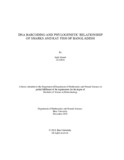| dc.contributor.advisor | Siddique, Romana | |
| dc.contributor.advisor | Ahmed, Md. Sagir | |
| dc.contributor.author | Ahmed, Sajid | |
| dc.date.accessioned | 2020-02-16T08:34:07Z | |
| dc.date.available | 2020-02-16T08:34:07Z | |
| dc.date.copyright | 2019 | |
| dc.date.issued | 2019-12 | |
| dc.identifier.other | ID 16136016 | |
| dc.identifier.uri | http://hdl.handle.net/10361/13760 | |
| dc.description | This thesis is submitted in partial fulfillment of the requirements for the degree of Bachelor of Science in Biotechnology, 2019. | en_US |
| dc.description | Cataloged from PDF version of thesis. | |
| dc.description | Includes bibliographical references (pages 49-52). | |
| dc.description.abstract | Objective: The Lack of proper identification of various sharks and ray species has been a far cry
among scientists. Cytochrome c oxidase gene-based DNA barcoding is used in various species
identification not only because of pinpoint accuracy but how it can be used only a small amount
of sample which doesn’t have proper morphological identification scope. So a need for a strong
database of these sharks and rays identifying marker Cytochrome c oxidase gene is needed to
crosscheck, regulate and update for current use and future reference.
Methods: Collection of samples were done from the southern region of Bangladesh in the Bay
of Bengal at various points and times. To identify the species a partial portion of it was collected,
in general an approximate 650bp sequence of the mitochondrial cytochrome c oxidase subunit I
(COI) gene is taken in consideration for this study. Since cytochrome c oxidase gene is easy to
multiply in numbers with specified primers, a good number of outcomes are taken into
consideration via Sanger-Sequencing method. The raw sequences were then trimmed according
to match value and uploaded to NCBI database from where a cross match is done to verify the
sequences. Further analysis was done using both offline and online resources of bioinformatics
tools.
Results: Our study concluded results that the K2P percentage of intra species of sharks and rays
cluster around a close range of 1% to 6.5% in intra species and the range is spread from 11% to a
maximum of 64% between species which gives us a genetic gap of 4.5%. For sharks, the GC1,
GC2, and GC3 codons were 52.52 ± 0.23, 42.89 ± 0.04, and 20.38 ± 0.31, respectively with an
average GC percentage being 38.59 ± 0.12 in the 8 species of sharks. For the rays, the GC1, GC2,
and GC3 codons were 53.96 ± 0.36, 43.48 ± 0.19, and 33.59 ± 0.44, respectively with an average
GC percentage being 43.67 ± 0.28 among 10 species of rays. Amino acid profiling showed clear
similarities among the percentage of amino acid translated from the mitochondrial COI gene of
same species and a significant difference between intra and inter species which makes it a good
second marker apart from the GC percentage via DNA barcoding method.
Conclusion: This study proved that COI gene-based DNA barcoding is a sound technique for
rapid and accurate identification of sharks and rays also amino acid profiling can also be set as
possible additional identification marker. | en_US |
| dc.description.statementofresponsibility | Sajid Ahmed | |
| dc.format.extent | 52 pages | |
| dc.language.iso | en | en_US |
| dc.publisher | Brac University | en_US |
| dc.rights | Brac University theses are protected by copyright. They may be viewed from this source for any purpose, but reproduction or distribution in any format is prohibited without written permission. | |
| dc.subject | Cytochrome c oxidase | |
| dc.subject | DNA barcoding | |
| dc.subject | Ray fish | |
| dc.subject | Marine Sharks | |
| dc.subject.lcsh | Cytochromes | |
| dc.title | DNA barcoding using Cytochrome c oxidase gene marker of Marine Sharks and Ray fish of Bangladesh | en_US |
| dc.type | Thesis | en_US |
| dc.contributor.department | Department of Mathematics and Natural Sciences, Brac University | |
| dc.description.degree | B. Biotechnology | |

